Types of geckos encompass a diverse array of lizard species, each with its own unique characteristics and traits. From the vibrant hues of the crested gecko to the camouflaged mastery of the satanic leaf-tailed gecko, these creatures captivate reptile enthusiasts worldwide.
Some, like the giant day gecko, boast striking colors and lively personalities, while others, such as the elusive flying gecko, showcase remarkable adaptations for survival.
Whether it’s the impressive size of the Leachianus gecko or the delicate beauty of the gold dust day gecko, exploring the world of geckos reveals a fascinating tapestry of biodiversity and evolutionary wonder.
Different Types of Geckos
Leopard Gecko
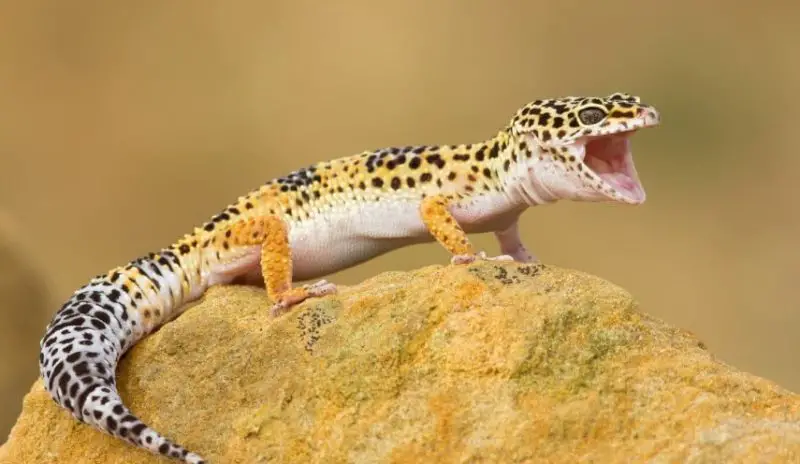
Because of their easy-care requirements and placid disposition, leopard geckos are quite popular pets. Their bodies are tan-yellow with brown or black patches that resemble the coat of a leopard. They cannot climb walls because they do not have rounded toe pads like other geckos do.
Leopard geckos also have eyelids, which distinguish them from other geckos and give their faces expression. These geckos are great for beginners because they don’t climb branches; instead, they do well in tiny cages with pebbles and logs. Although they eat a variety of foods, they seem to prefer insects like grub worms and crickets.
Leachianus Gecko
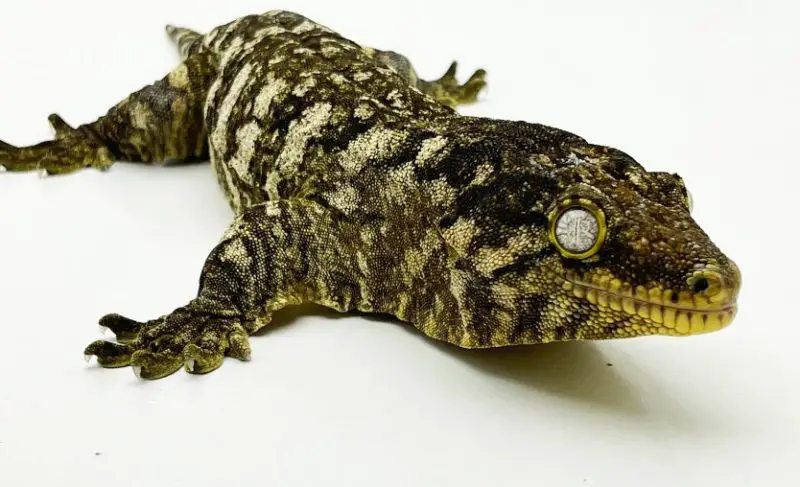
The Leachianus gecko, also known as the New Caledonian giant gecko, is recognized by various names reflecting its size and habitat. As the largest living member of the gecko family, adults can reach lengths of up to 17 inches. Caring for them requires spacious, well-crafted enclosures with vertical space for climbing.
While generally peaceful, they may exhibit territorial behavior, especially when unfamiliar with other geckos. Handling should be minimal, as they may become agitated and attempt to free themselves. These geckos prefer blending into their surroundings and relaxing during the day, making them fascinating yet demanding pets.
Tokay Gecko
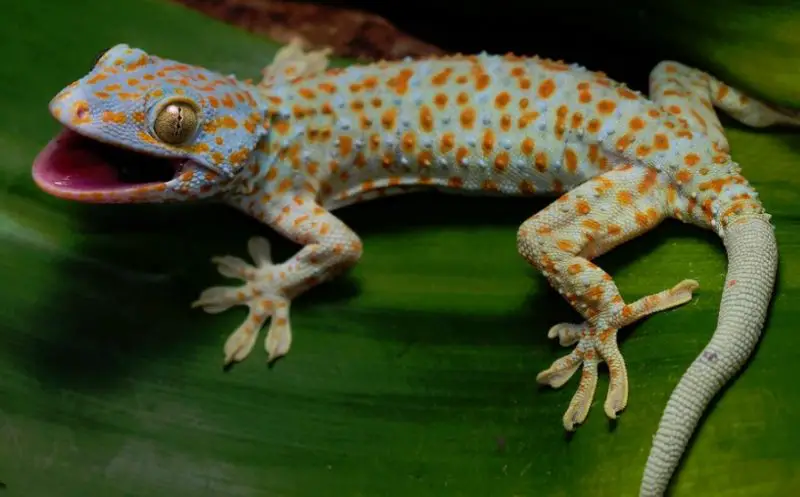
Herpetology fans are enthralled by tokay geckos due to its striking coloring, which consists of light blue or gray tones accented with striking red, orange, yellow, or green spots.
But their hard character belies their attractiveness, so novice reptile keepers should avoid them. Tokay geckos are extremely territorial and frequently get into battles that end in fatalities or major injuries. Even partners that seem to get along might occasionally spar. Building trust is necessary while handling tokay geckos since they have sharp, tiny fangs that can bite.
While they may become more accepting of handling as they age, the risk of aggression remains. Careful monitoring and prompt intervention are necessary when housing multiple tokay geckos together.
Flying Gecko
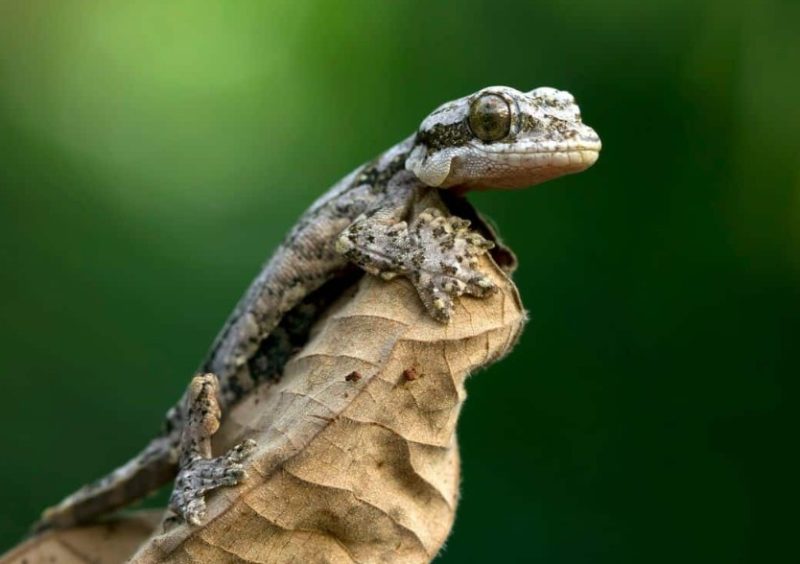
Flying geckos are elusive arboreal critters that are native to the rainforests of Southeast Asia and are distinguished by their extraordinary ability to glide from tree to tree. Their billowy skin catches the wind like a wingsuit, enabling them to soar with ease. Their dark, splotchy skin helps them blend in with their surroundings, and they have huge webbed feet for extra control. They are experts at camouflage in the trees.
Though they have an intriguing appearance, flying geckos are not appropriate for handling due to their timid and fragile nature. Since they are prone to accidents due to their delicate skin, it is crucial to observe them from a distance in their natural habitat.
Satanic Leaf-Tailed Gecko

The satanic leaf-tailed gecko, which is indigenous to Madagascar’s highland rainforests, is an expert at camouflage, often appearing as dead leaves to elude predators. This gecko’s look is its only demonic quality, despite its sinister moniker. Its head is shaped like a triangle and has vertically slitted red or white eyes with protrusions that resemble horns. The fanned tail resembles fallen foliage, while the body resembles the veins of leaves.
These geckos appear frightening, yet they are not harmful. Acquiring one is a valued addition to any collection, demonstrating the extraordinary adaptability and beauty of nature.
Giant Day Gecko
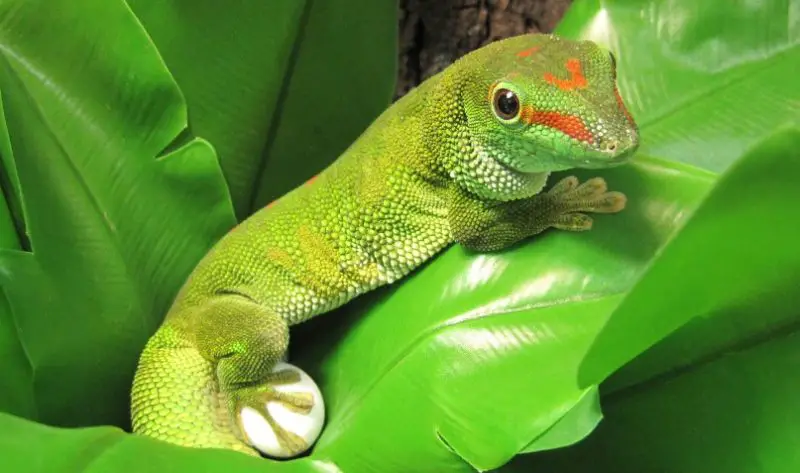
When fully grown, giant day geckos can reach lengths of approximately 12 inches; therefore, they need large enclosures to survive. They are colorful and active animals.
Because they are arboreal, they need lots of room to climb and strong branches and vines to maintain their girth. These geckos have striking colors, with highlights of red and yellow and a jewel-toned green. Their climbing-oriented, cushioned toes are a reflection of their arboreal way of life. They are naturally frightened and flighty, and they would rather not be handled.
When they feel threatened, they have a unique defense mechanism that allows them to shed their soft skin and escape from stimuli. Attempting to handle them may set this mechanism off.
Yellow-Headed Day Gecko
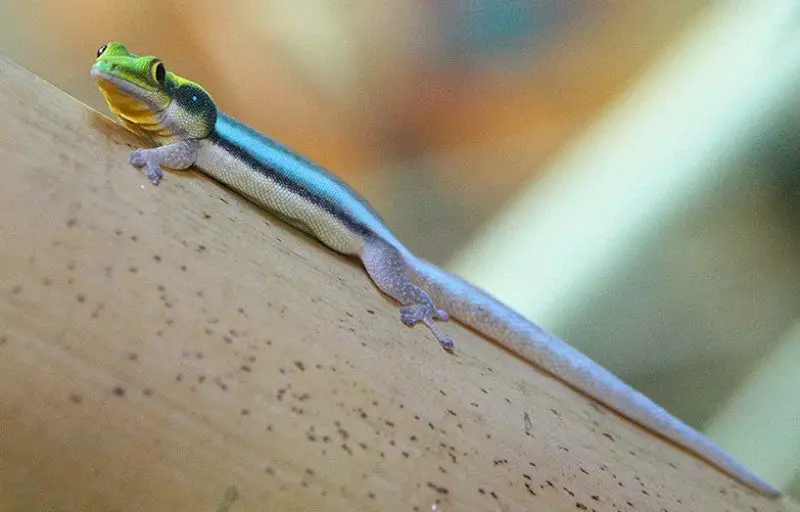
The bright colors of the yellow-headed day gecko make it easy to identify the smallest member of the day gecko family. It has a vivid yellow head, lively turquoise on the lower back and tail, and light brown patches on the lower back. This diurnal, flat-bodied gecko is highly active and thrives in vivariums with live plants and organic décor.
Because they are delicate and reticent, these geckos are best observed through glass. Handling frequently is not advised. Their eye-catching coloring is enhanced by natural-looking settings, where it is most visible.
White-Lined Gecko
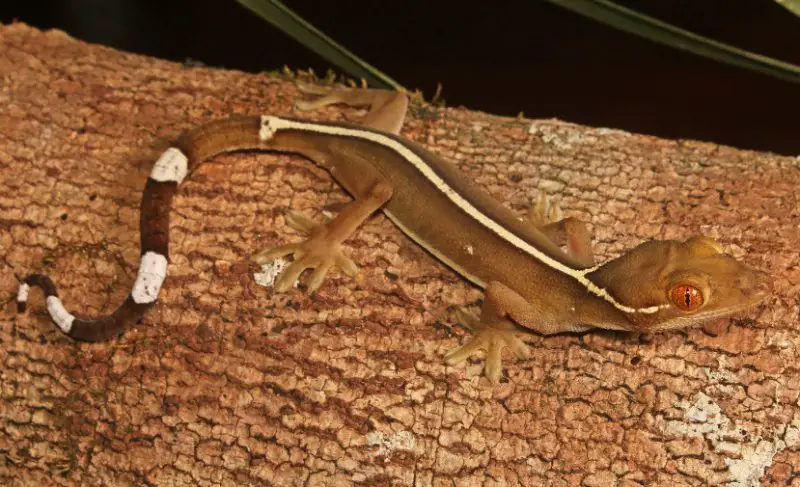
The vibrant species of white-lined geckos has a distinct design. Their body is mostly dark tan, green, or brown, but their frame is emphasized with prominent white lines, giving them a unique appearance. They can bite if threatened, even though they are not as erratic as some other geckos. Agile escape artists, if you attempt to hold them, they will run away fast.
The safe confinement of this species provides the optimum observational conditions. Their natural and vibrant habitat, filled with climbing branches, vines, and live plants, helps control their restless and aggressive tendencies.
Gargoyle Gecko
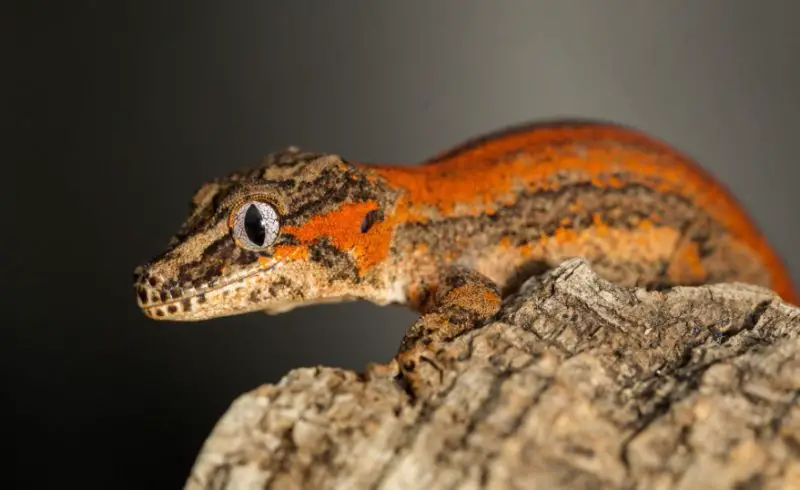
The gargoyle gecko’s unusual and eye-catching look gives it its moniker. The skin of this medium-sized gecko is splotchy, with sporadic patches of orange, yellow, and red highlights among its patches of gray, black, brown, and white. Its triangular-shaped head, with its huge, bulbous eyes giving it a statuesque appearance, is its most striking characteristic.
Gargoyle geckos are calm and love occasional handling, if they are not restrained, despite their frightening appearance. When they are with other geckos, though, they can get aggressive and even start fighting among themselves.
Gold Dust Day Gecko
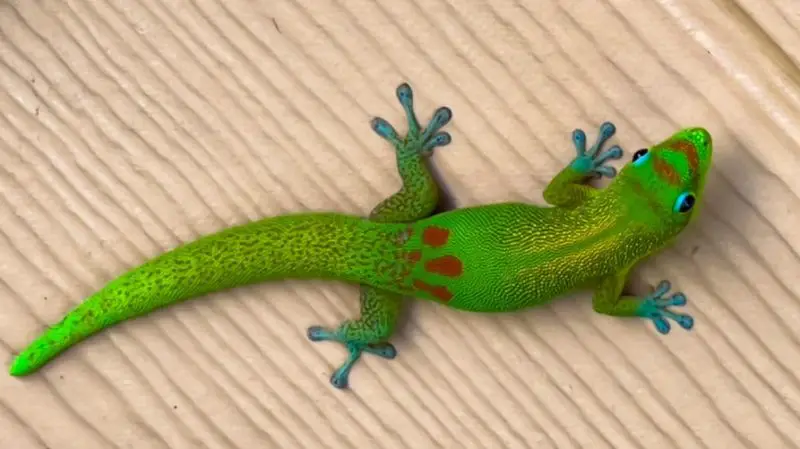
With a tail that only extends four to six inches, the gold dust day gecko is a small species. Their ease of maintenance and small area requirements make them suitable for novices. Due to their propensity for climbing, these geckos like enclosures that are tall enough and have a network of surfaces that they can climb, such as thin vines and broad cork branches.
Given their territorial attitude, housing two males together is not advised, even though they adapt well to a variety of habitat sizes. It is possible for males and females to be coupled, but a sizable enclosure is required to accommodate each.
Crested Gecko
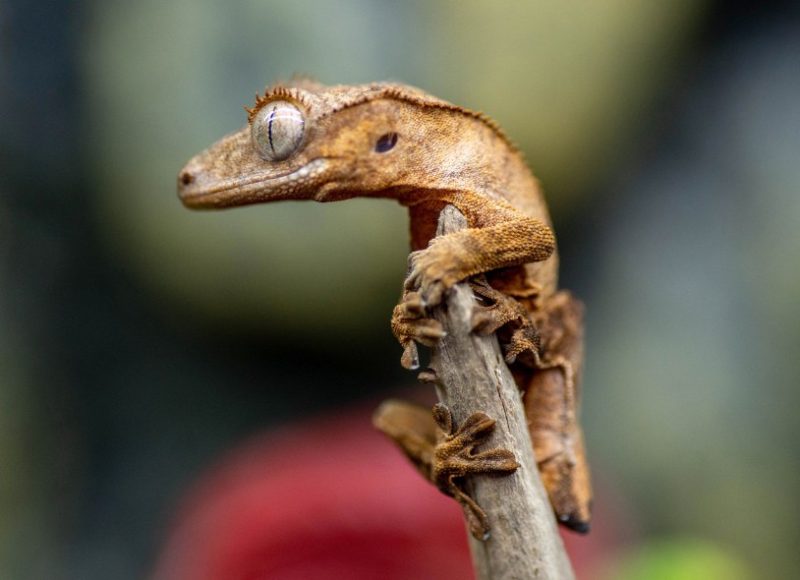
After being believed to be extinct, the crested gecko was rediscovered in New Caledonia and has since grown to be a popular pet species. Reptile aficionados of all ages can enjoy them because of their tough and friendly temperament.
Though more vivid shades are conceivable, muted tones of tan and brown are the most typical colors for crested geckos. The crest, which begins at the top of the head and runs down part of the back to give them a characteristically spiky appearance, is their most distinguishing characteristic.
African Fat-Tailed Gecko
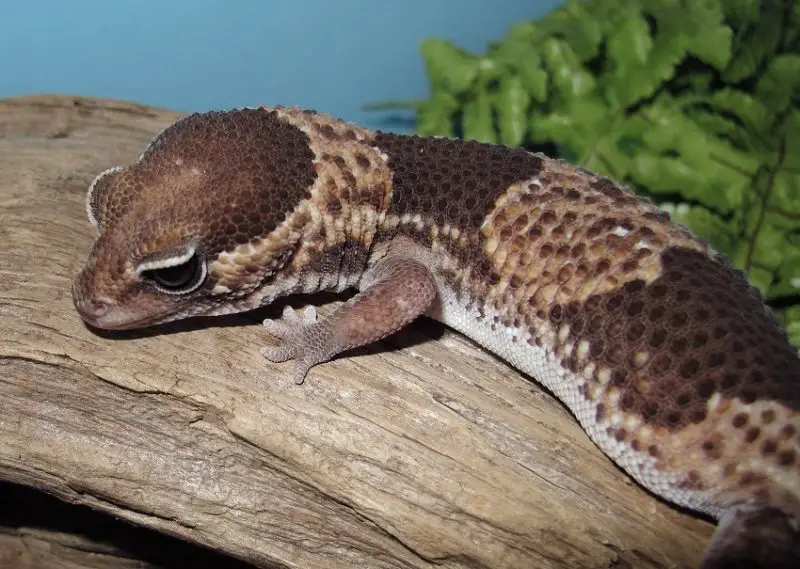
Originating from the dry regions of West Africa, the African fat-tailed gecko is a fascinating domestic animal. They provide their owners with a great deal, despite not being as well-known as other geckos. These geckos are usually docile and will trust and enjoy being handled once they feel at ease. Some might even react to sounds and visual signals.
However, they shouldn’t be kept together because males may be highly territorial and aggressive. With two females and one male, this species may survive on its own. They have a characteristic bulbous tail that stores fat for energy, and they appear in numerous forms.
Golden Gecko
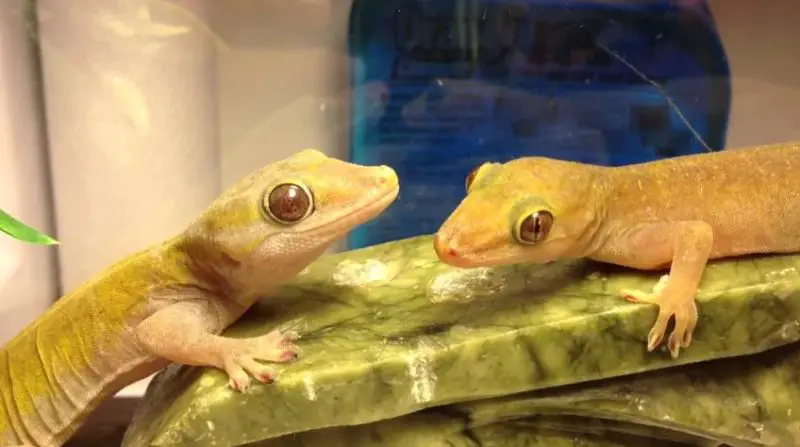
The golden gecko is a nocturnal species, naturally wary of humans, and not as common as other geckos. They require specific care and patience but can be rewarding pets. Males are covered in a vibrant yellow-gold color, often uniformly, though some may have black splotches on their backs. Females are less lustrous, with possible hints of green.
Golden geckos are not fond of handling due to their anxious demeanor and delicate skin, which can rip easily. They may bite or drop their tail if forced. Over time, they can become more receptive to light handling, but caution is always advised.
Mediterranean House Gecko
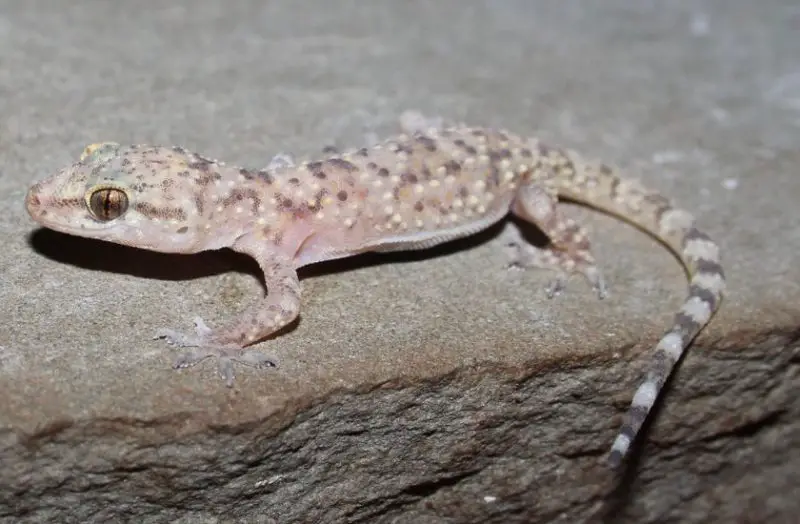
The little nocturnal lizard that goes by the name “moon gecko,” or Mediterranean house gecko, is most active in the hours following midnight. Drawn to light, they frequently congregate close to lit regions in order to capture insects. The skin of these geckos is tan with black dots that occasionally display purple splotches. They can be easily navigated by their lengthy, tactile digits and lidless eyes.
They are native to the Mediterranean region and like places by the water with lots of shade. Mediterranean house geckos are happy in both captivity and the wild because of their widespread popularity in the pet trade and innate resistance to insecticides.
Chinese Cave Gecko
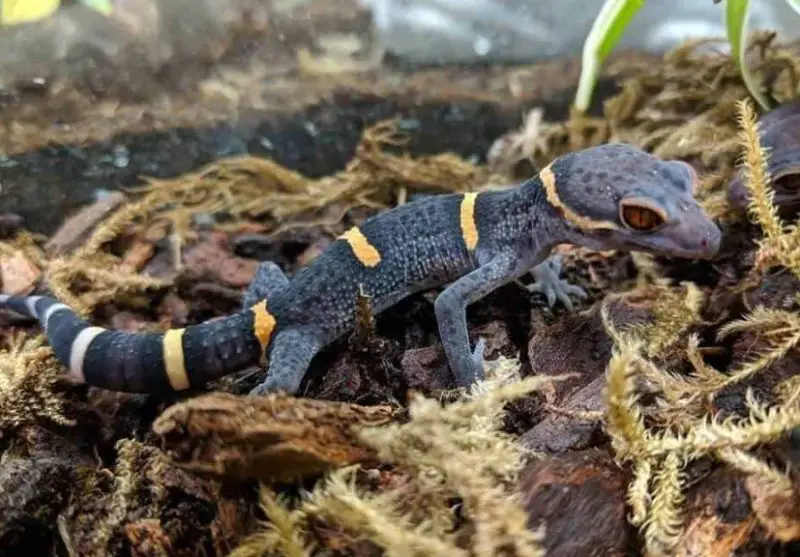
An uncommon and highly sought-after lizard native to China, specifically the Island of Hainan, is the Chinese cave gecko. They have successfully adapted to their nocturnal lifestyle and live in caverns found across lowland rainforests. These geckos have striking yellow stripes encircling their bodies and tails, and their bodies are mostly purple with black patches on their backs. Their vivid crimson eyes create a dramatic contrast.
Chinese cave geckos appear scary, but they are actually quite shy and cautious. They can become acclimated to human contact with time and careful handling. Being nocturnal animals, they are at their most active at sunset.
Chahoua Gecko
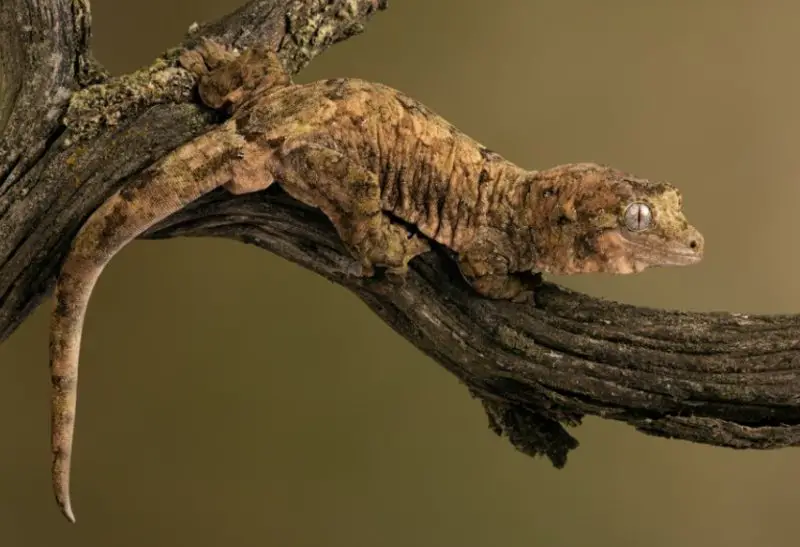
The mossy prehensile-tailed gecko, or chahoua gecko, is a master of disguise, fitting in perfectly with its dry tree home. Their eyes match the hue of their body, which is predominantly brown and resembles tree bark, with slightly darker lines.
Being arboreal by nature, their ideal habitat is one with lots of climbing surfaces and high walls. Their temperament and tolerance are variable, but they are surprisingly amenable to handling, and they can maintain composure with the right training. They need care to be managed because they are hyperactive as newborns. Reptile fans will find Chahoua geckos to be fascinating pets due to their distinctive appearance and adaptable temperament.
Frog-Eyed Gecko
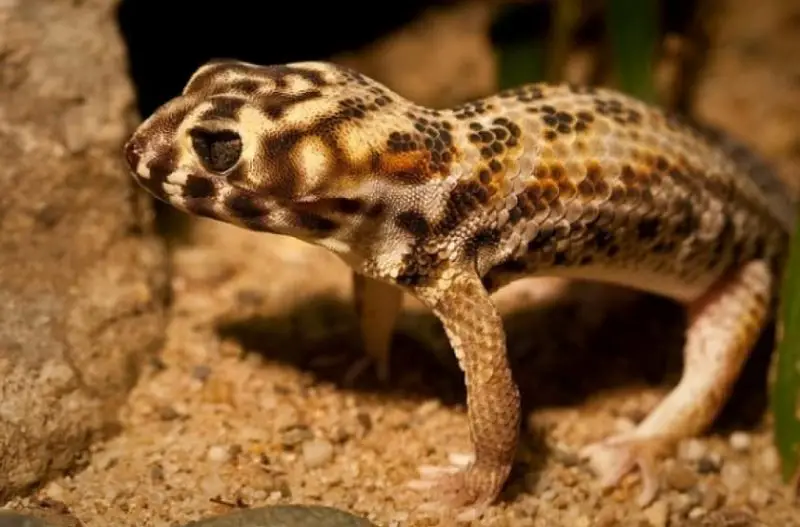
Large, bulbous eyes and a spherical head distinguish frog-eyed geckos from other species of geckos. These geckos stand out from the majority of geckos with triangular heads. Originating from arid shrublands and even open deserts in the Middle East and Asia, wild-caught species are frequently seen in the pet trade. Their great range of appearances is a reflection of their many habitats.
Even though they don’t have any valuable morphs, collectors like them because of the small color variations that depend on the location. They may be kept healthy with ease by providing them with an insect diet and enclosures modeled as deserts. They eat anything, and in captivity, they do best with variety and appropriate nourishment.
Western Banded Gecko
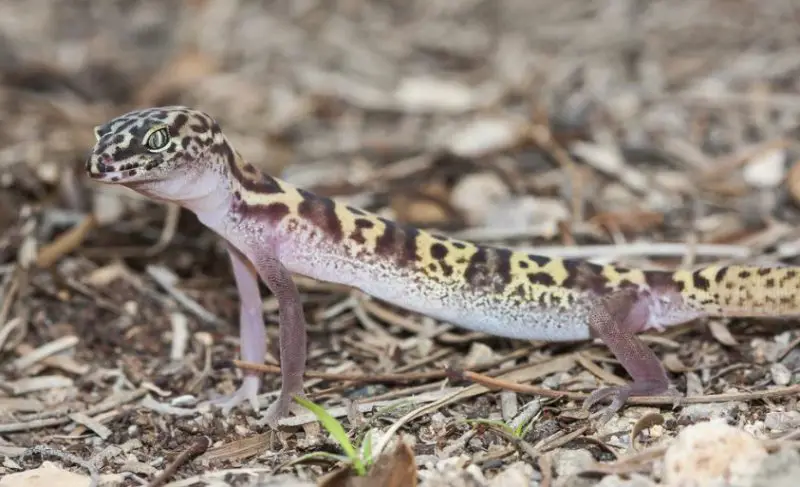
Western Banded Gecko (Coleonyx variegatus) is 2 to 3 inches long with movable eyelids and vertical pupils. It has pink to pale yellow coloring with brown bands on its back and tail, and a white to off-white belly. Notably, it makes a small squeaking noise when disturbed. Adapted to arid climates, this nocturnal gecko spends much of its time underground. It uses rocks and debris for cover and eats insects and spiders. Four subspecies exist in the U.S.
Texas Banded Gecko

The Texas Banded Gecko (Coleonyx brevis) is 1.5 to 2.5 inches long with yellowish-tan coloring and wide dark bands across its body and tail. The granular scales give its skin a sandpaper-like texture. This species is common in desert grasslands and open woodlands, often found near hillsides and canyons. Mostly terrestrial, they climb rocks for shelter. Females lay large eggs, often wider than their bodies, with clutches of one or two eggs.
Bi-Coastal Geckos
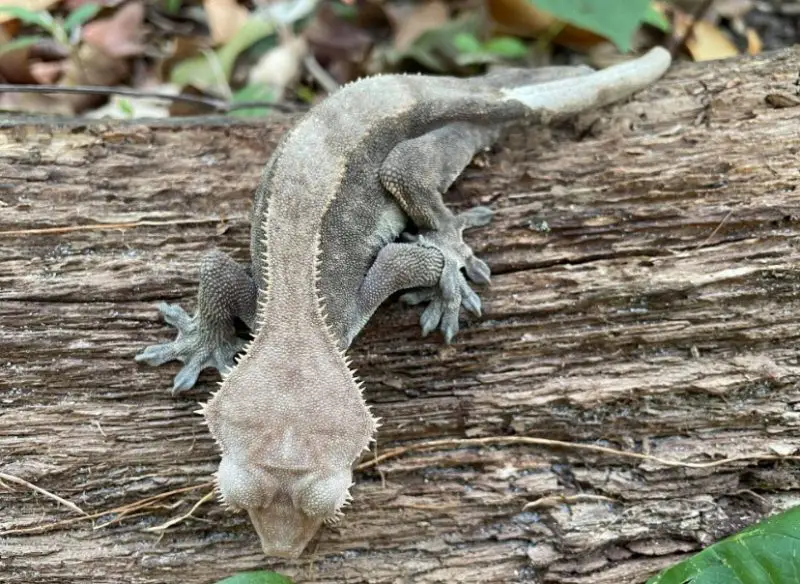
Bi-Coastal Geckos in the United States include three non-native species introduced to Florida and California via agriculture and the pet trade. They thrive in urban and suburban areas, often found inside buildings. Adapted to their environments, they spread quickly and eat insects, helping to keep buildings pest-free. These geckos are well-integrated into their new habitats and contribute to local pest control.
Reticulate Banded Gecko
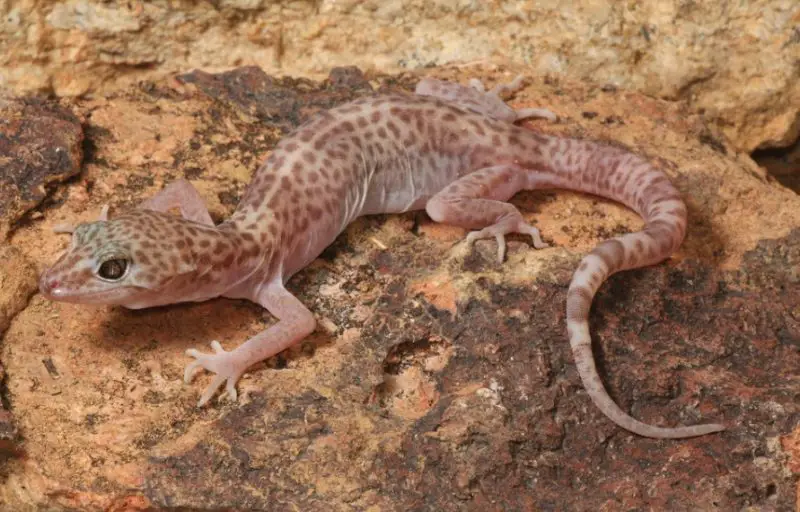
Reticulate Banded Gecko (Coleonyx reticulatus) is 5.5 to 6.75 inches long, light brown with darker streaks and spots forming a fishnet pattern. Its eyes are dark with immobile eyelids. Found only in Texas, it is larger and has a smaller range than the Texas Banded Gecko. It eats various arthropods and is vocal, squeaking when disturbed or handled.
Rough-Tailed Gecko

Rough-Tailed Gecko (Cyrtopodion scabrum) is 3 to 4.5 inches long, sandy brown with dark brown spots forming a striped pattern, and has a white belly. Its tail has dark brown crossbands and large, keeled scales. A non-native species, it is found only around the Galveston commercial shipping docks in Texas, introduced via produce ships. Its natural range spans from Sudan to northwestern India.
Barefoot Gecko
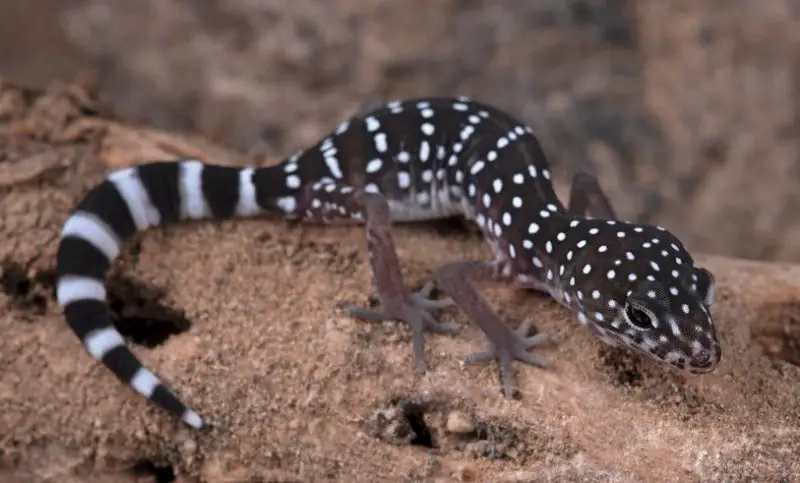
Barefoot Gecko (Coleonyx switaki) is 2 to 3.5 inches long, pale beige to reddish-brown with brown spots and lighter spots forming crossbands on its back. In the U.S., they inhabit flatlands and canyons with rock outcrops. Nocturnal and hiding in crevices, they squeak when disturbed. Uniquely, they wave their curled tails to appear larger and deter predators.
Leaf-Toed Gecko
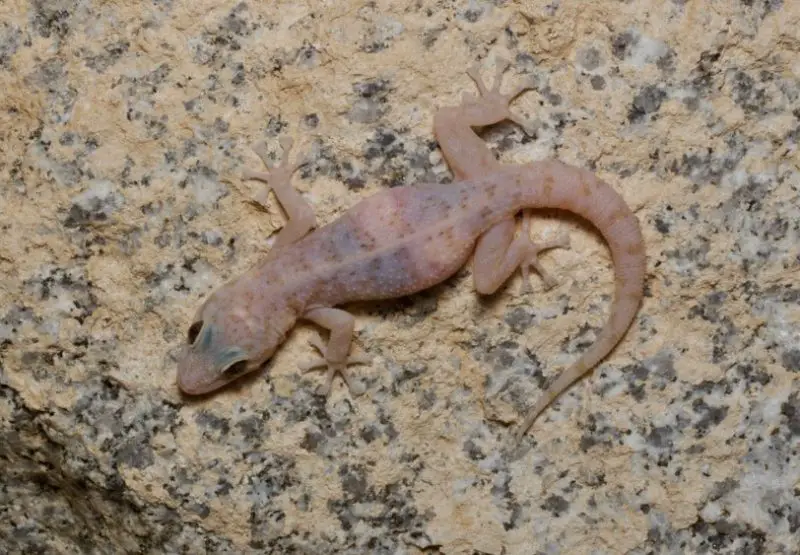
Leaf-Toed Gecko (Phyllodactylus xanti) is 1.5 to 2.5 inches long, with toes resembling a tropical leaf. It is pink, brown, or gray, with dark brown spots and a pale belly. Found in rocky terrain in far southern California, they prefer areas near streams or rivers but can live far from water. They eat insects and spiders. The U.S. subspecies, P.x. nocticolus, is the larger one. They squeak when disturbed.
Sri Lankan House Gecko
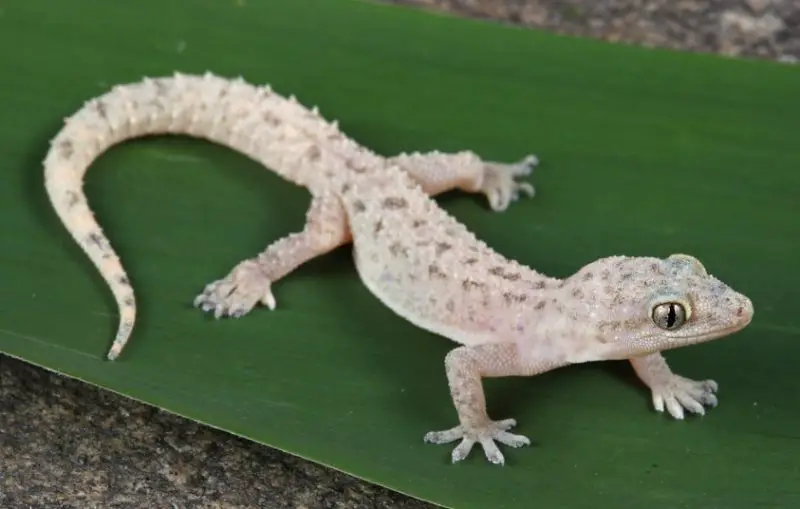
Sri Lankan House Gecko (Hemidactylus parvimaculatus) is 4 to 4.5 inches long, brown with rows of small, irregular darker brown spots, and small bumps called tubercles down its back. Found only in the Audubon Park area of New Orleans, it likely arrived via shipping containers. Their call is a throaty “chuk-chuk-chuk” sound. Naturally, they inhabit southern India, Sri Lanka, and islands in the Indian Ocean.
Florida Reef Gecko
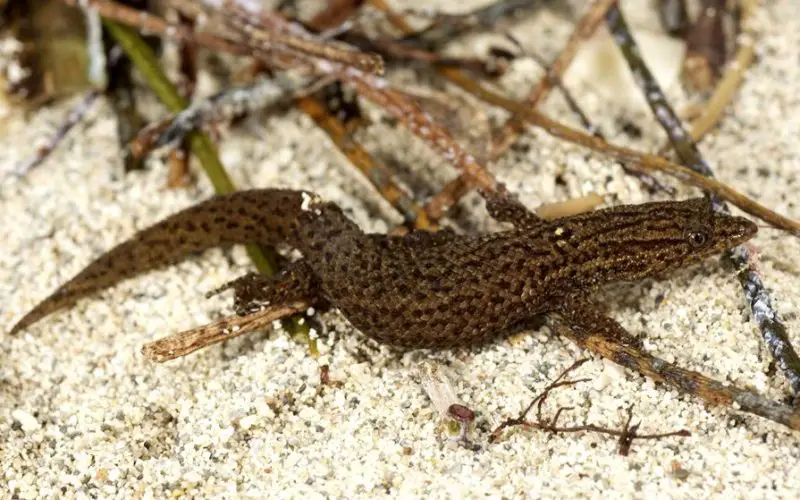
The Florida Reef Gecko (Sphaerodactylus notatus) is 2 to 2.25 inches long, brown with small dark spots that fade with age. Females have three broad stripes on their heads, with a lighter middle section. Native to southern Florida, they inhabit pine forests, vacant lots, and buildings, often hiding under debris. Known as Brown-speckled Sphaeros, they are the only native gecko species in Florida, with all others being invasive.
Bibron’s Sand Gecko
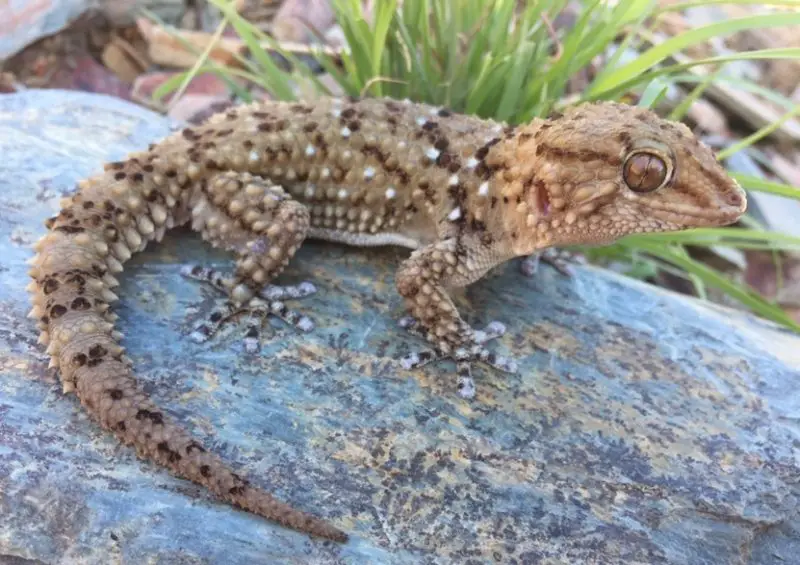
Native to southern Africa, the Bibron’s Sand Gecko (Chondrodactylus bibronii) is a rarity in the United States, found only in Bradenton and Manatee counties in Florida. It is characterized by its thick, stout body and large head. Typically olive to tan with dark crossbands, this gecko thrives in sandy habitats. Its limited presence in Florida makes it a unique and intriguing species for local herpetologists and reptile enthusiasts.
Common House Gecko
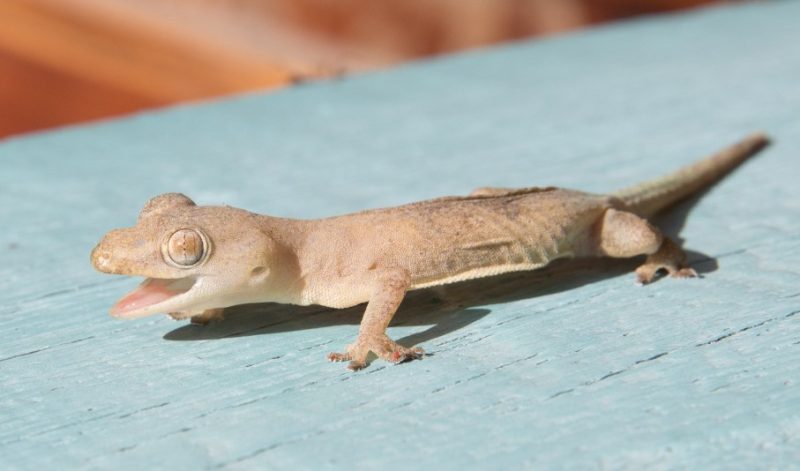
Originally from Southeast Asia, the Common House Gecko (Hemidactylus frenatus) has established itself in southern Florida. Sporting tan or gray coloring with dark stripes or spots, it’s easily recognizable. Notably, this gecko species features light lines through its pupils. Its adaptability and widespread presence in urban areas make it a familiar sight for residents, often spotted scurrying along walls or ceilings in search of insects during warm evenings.
Tropical House Gecko
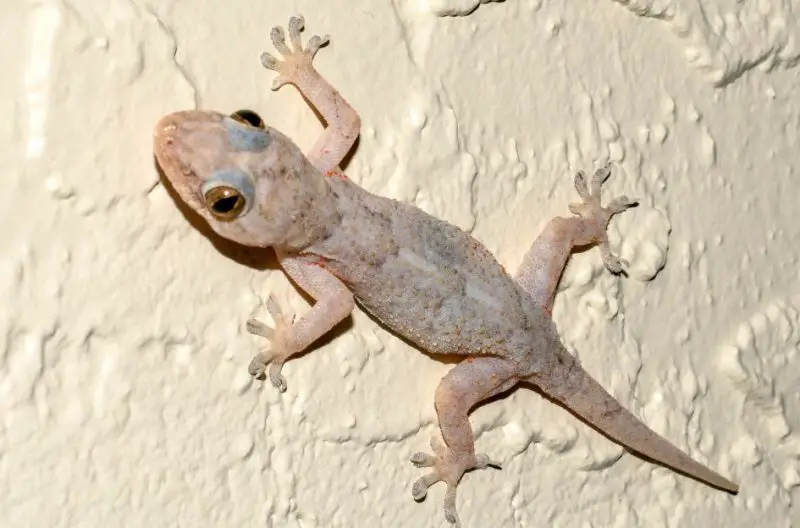
Inhabiting the Florida peninsula and the Keys, the Tropical House Gecko (Hemidactylus mabouia) hails from tropical Africa. Its appearance is characterized by uniform pale gray or light brown coloring adorned with thin, dark crossbands. This adaptable species thrives in urban and suburban environments and is often seen scaling walls or perching on ceilings. Its widespread presence in Florida underscores its ability to thrive in a variety of habitats and climates.
Asian Flat-Tailed House Gecko
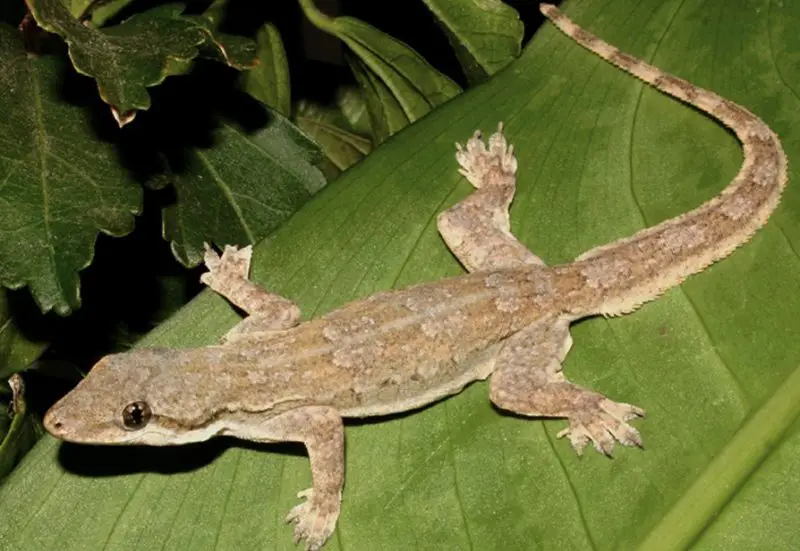
Originally from Nepal, eastern India, and Southeast Asia, the Asian Flat-Tailed House Gecko (Hemidactylus platyurus) has established scattered populations across the Florida peninsula. One of its distinctive features is its flat tail, which resembles an arrowhead or handmade knife due to its serrated edge. This unique adaptation likely aids in camouflage and locomotion, allowing it to navigate its urban and suburban habitats with ease.
Madagascan Day Gecko

Native to Madagascar, the Madagascan Day Gecko (Phelsuma grandis) thrives in South Florida and the Keys. Its vibrant green coloring, adorned with orange or red spots, makes it a striking sight. Notably, this species stands out among geckos for its round pupils, a distinguishing feature. With its eye-catching appearance and active daytime habits, the Madagascan Day Gecko adds a splash of tropical beauty to its subtropical habitats in the United States.






